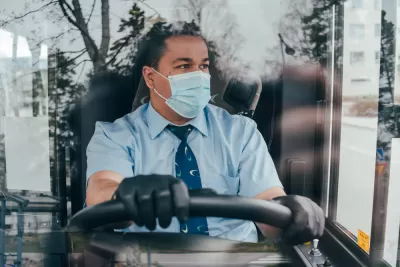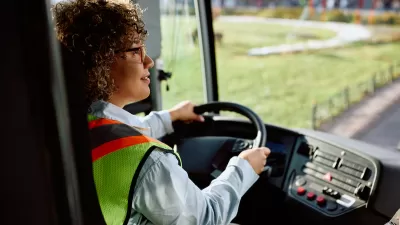More than nine in 10 U.S. transit agencies face operator shortages. A new report sheds light on the reasons why they’re having such a hard time attracting new hires.

A new report from Transit Center describes the operator shortage facing more than 90 percent of American transit agencies, which are struggling to fill bus driver positions. As Kea Wilson reports in Streetsblog, “those shortfalls are forcing a staggering 71 percent of providers to either cut or delay service, while others, like Los Angeles, are postponing service upgrades that would increase shared mobility access in the Black and brown neighborhoods that need it most.”
Wilson outlines the four reasons TransitCenter gives for the operator shortage. These include low starting pay and high retirement rates, workplace assault, “punishing” schedules, and an overall lack of respect and dignity—and restrooms. “A stunning 80 percent of transit workers say that not enough time is built into their schedules for them to simply use the bathroom — if they can even find one, given the dearth of public restrooms in most US cities, particularly during the pandemic — and 67 percent report that they’ve experienced health problems as a consequence.”
In addition to establishing channels for operators to voice their concerns to agency officials, report author and TransitCenter program manager Chris Van Eyken “emphasizes that agencies must take systemic approaches to making drivers feel valued and heard, starting with strong pay, strong safety protections, and schedules that they and their families can sustain.” Agencies must recognize the crucial role of operators in making transit systems function—and treat them accordingly.
FULL STORY: Four Factors Driving the Bus Operator Shortage (And What to Do About Them)

Study: Maui’s Plan to Convert Vacation Rentals to Long-Term Housing Could Cause Nearly $1 Billion Economic Loss
The plan would reduce visitor accommodation by 25,% resulting in 1,900 jobs lost.

North Texas Transit Leaders Tout Benefits of TOD for Growing Region
At a summit focused on transit-oriented development, policymakers discussed how North Texas’ expanded light rail system can serve as a tool for economic growth.

Using Old Oil and Gas Wells for Green Energy Storage
Penn State researchers have found that repurposing abandoned oil and gas wells for geothermal-assisted compressed-air energy storage can boost efficiency, reduce environmental risks, and support clean energy and job transitions.

Santa Barbara Could Build Housing on County Land
County supervisors moved forward a proposal to build workforce housing on two county-owned parcels.

San Mateo Formally Opposes Freeway Project
The city council will send a letter to Caltrans urging the agency to reconsider a plan to expand the 101 through the city of San Mateo.

A Bronx Community Fights to Have its Voice Heard
After organizing and giving input for decades, the community around the Kingsbridge Armory might actually see it redeveloped — and they want to continue to have a say in how it goes.
Urban Design for Planners 1: Software Tools
This six-course series explores essential urban design concepts using open source software and equips planners with the tools they need to participate fully in the urban design process.
Planning for Universal Design
Learn the tools for implementing Universal Design in planning regulations.
Ascent Environmental
Borough of Carlisle
Institute for Housing and Urban Development Studies (IHS)
City of Grandview
Harvard GSD Executive Education
Toledo-Lucas County Plan Commissions
Salt Lake City
NYU Wagner Graduate School of Public Service





























